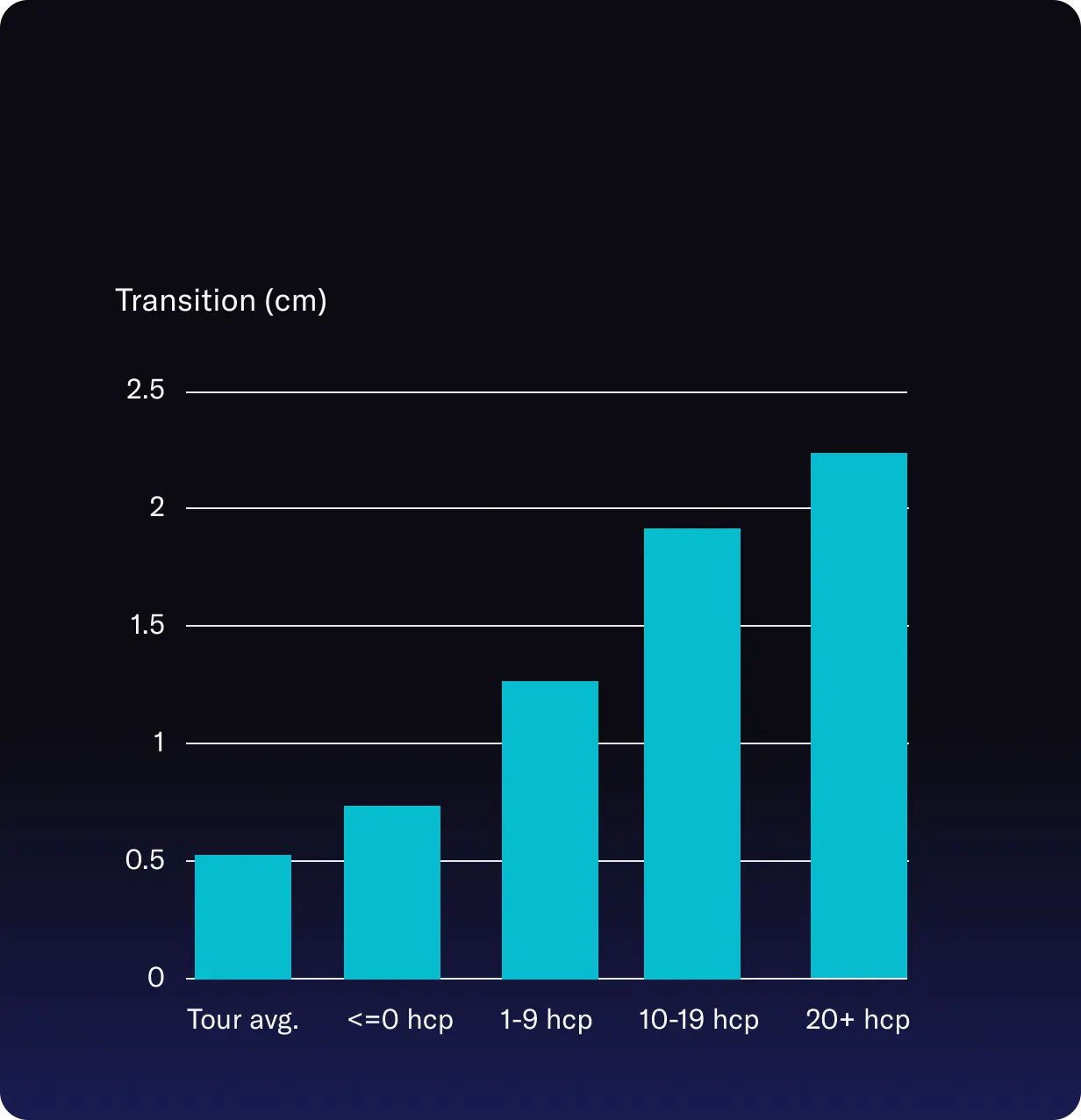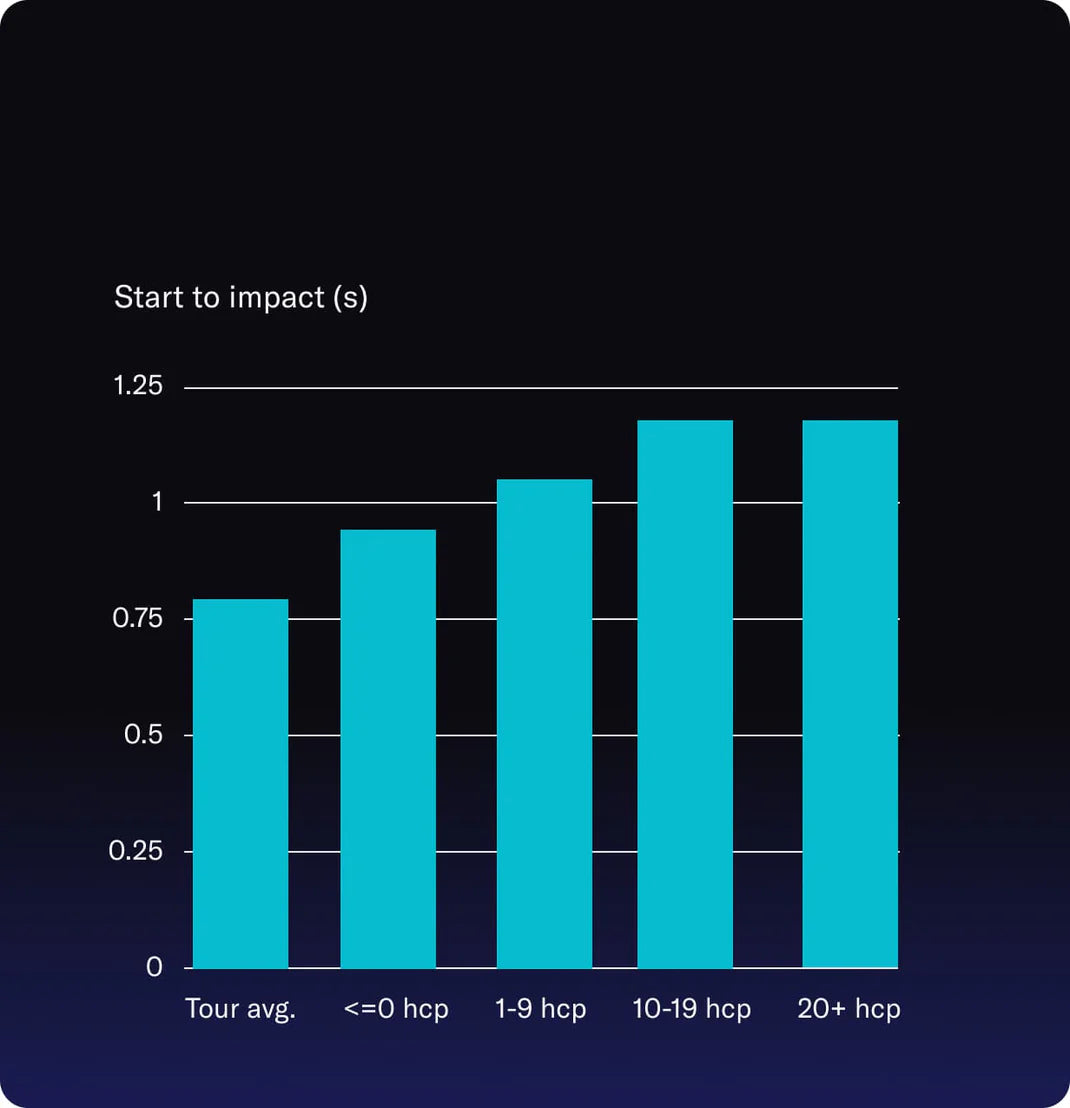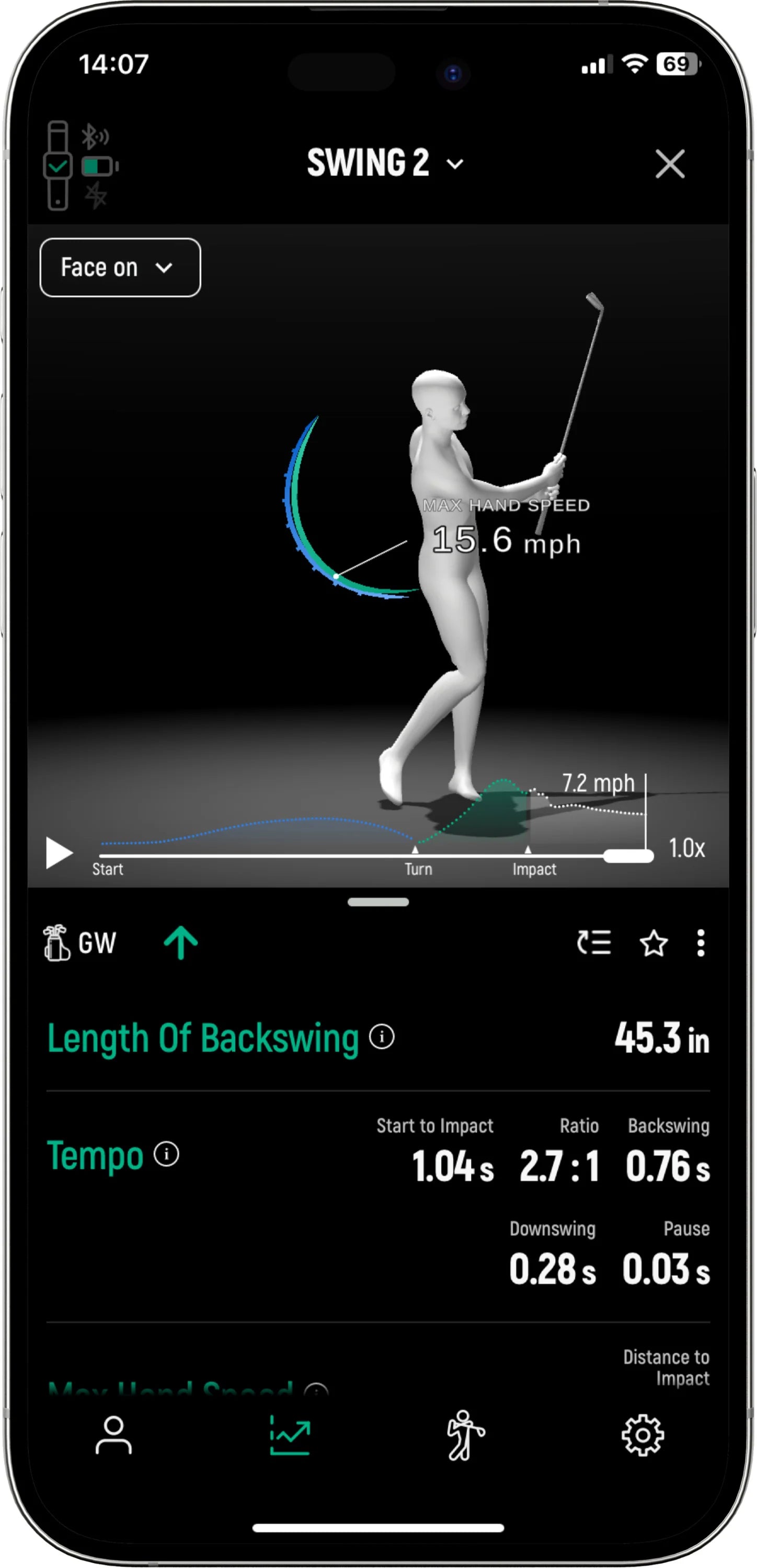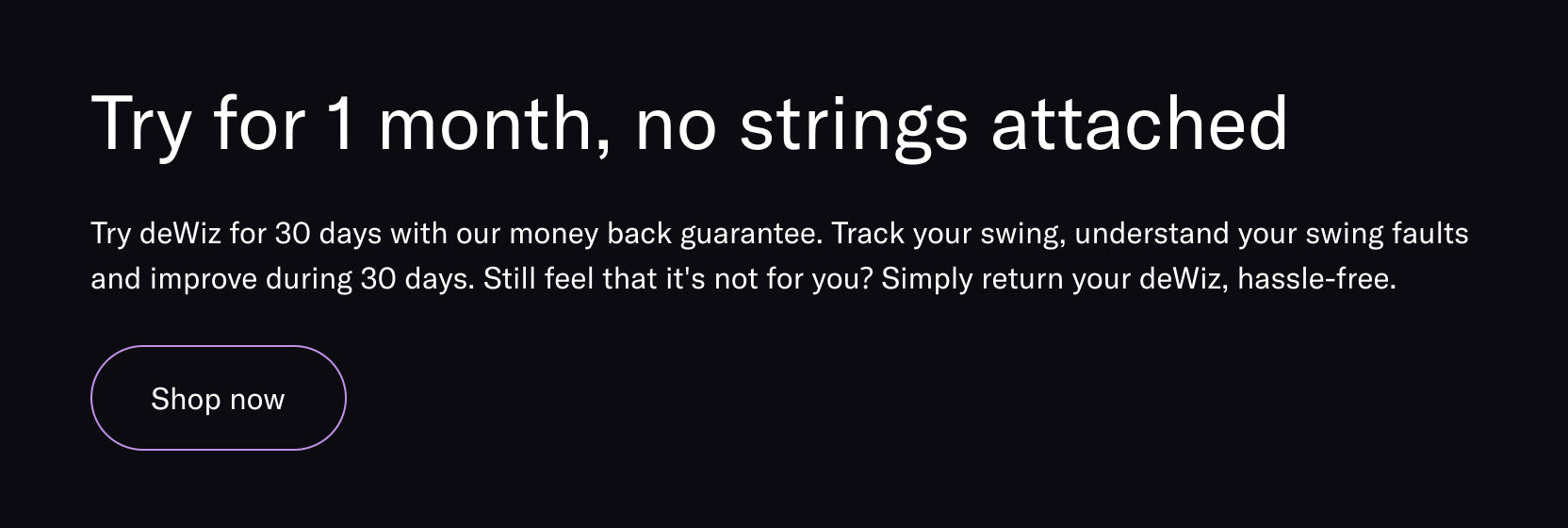What we measure
Each swing recorded with deWiz presents 14 unique measurements in addition to a 3D-rendering model to show the hand path on that particular swing.
Fix your slice
Getting rid of a slice ball flight comes down to changing your downswing direction. deWiz offers four measurements that directly indicate how the hands move through transition to help redirect the downswing path.
-
Transition
Distance between the backswing and downswing
Tour average: 0 in/cm
-
Backswing Plane
Angle the hands travel from address to the top of the backswing
Tour average: 70°
-
Initial Downswing Direction X
Direction the hands move at the start of the downswing
Tour average: 10°
-
Steepening/Shallowing
Rotation of the forearm to indicate angle of the club shaft
Tour average: -2-2°
Collapsible content

Transition
deWiz Transition is a distance measurement between the backswing and downswing hand path planes. A positive (+) measurement indicates the downswing plane starts above the backswing plane, and conversely, a negative measurement (-) shows the downswing dropping below the backswing.
Most high-level players maintain a neutral transition (+/- 1 in), whereas players that struggle with big left and right misses tend to have more positive Transition measurements leading to less control of the club face.
Backswing Plane
The Backswing Plane measurement from deWiz shows the direction the hands moved from takeaway to the top of the backswing. In essence, the data point shows if your backswing is too steep or too flat.
Typically, golfers that have excessively positive Transition numbers will tend to have a flatter Backswing Plane and should focus on taking the club back on a steeper plane.
Initial Downswing Direction X
Abbreviated as IDDx in the deWiz app, this is a unique measurement to illustrate the direction the hands are moving at the beginning of the downswing. Similar to the deWiz Transition data point, a more positive IDDx measurement means the hands are moving more to the outside and setting that out-to-in path.
Most TOUR players have an IDDx in the 5-15° range - indicating that the hands fall downwards at turn.
Steepening/Shallowing
Also commonly referred to as Pronation/Supination, the Steepening/Shallowing data point provided by deWiz measures the rotation of the lead forearm through transition. Ultimately, this rotation controls the shaft angle of the club with a positive (+) measurement meaning the club is steepening and a negative (-) number indicating shallowing of the club.
While most high-level players will demonstrate a small degree of shallowing, the common theme is that better players have less rotation in either direction. More wrist rotation leads to less clubface control.

Data Research
Better players have a neutral Transition
Better players tend to consistently produce a more neutral transition, helping to produce more clubface control and a straighter ball flight compared to higher handicap players.
Add distance
Increasing clubhead speed is something that all golfers are capable of achieving when provided with the necessary feedback. deWiz has helped golfers of all skill levels reach their distance potential by tracking the length and speed of the golf swing.
-
Length of Backswing
Distance the hands travel from takeaway to the top of your backswing
Tour average: 60 in/154 cm
-
Tempo
Time it takes for each component of the golf swing
Tour average: Start-to-impact <1 second
-
Hand Speed
Speed at which the hands move throughout the golf swing
Tour average: >20 mph
-
Max Backswing Width
Widest point the hands reach during the backswing
Tour average: 22 in/56 cm
Collapsible content

Length of Backswing
In looking at data collected from millions of deWiz swings, the most surefire way we see of adding clubhead speed is to lengthen your backswing. Whether you are a “short-swinger” like Jon Rahm or Tony Finau, or a “long-swinger” in the mold of Ernie Els or Vijay Singh, any golfer can tap into some potential by swinging the club longer.
deWiz Length of Backswing measurement helps the golfer confirm that they truly are making a longer swing, rather than needing to rely on feel or video footage after the fact.
Tempo
deWiz breaks down the golf swing into five different tempo measurements with two that relate directly to speed: Backswing Duration and Start-to-Impact Duration.
There’s been a long standing motto when it comes to the golf swing that you should take the club back “Low and Slow”. Our data shows that the majority of amateur golfers are swinging the club back too slowly. Speeding up the backswing and - in return - speeding up the total time it takes to complete a swing will instantly unlock potential distance.
Hand Speed
If we are trying to get the clubhead to speed up, it only makes sense to have the hands moving faster. Beneath the avatar in the deWiz app, you will see a continuous curve to indicate the speed the hands are moving at each point in the golf swing.
While faster hands will certainly lead to more distance, the way in which the hand speed is distributed is a direct reflection of the efficiency of the golf swing. The hand speed curve can even be used to quantify the lag angle of the swing - something that is typically unmeasurable.
Max Backswing Width
One way to create a longer swing is to create a wider swing. Measured as a straight line from the address position to the widest point in the backswing, the Max Backswing Width measurement is a perfect way for players that struggle getting depth in the backswing to confirm they are making progress.
Because the deWiz Length of Backswing measurement is taken by the length of the hand path arc, a wider swing is going to translate to a longer Length of Backswing.

Data Research
We've done the research. Better players swing faster
In analyzing millions of swings we see that almost all tour players go from start of swing to ball impact way faster than the average golfers. Pro players know that speed = distance. If you want to add distance, mimic a tour pro and swing faster.
Improve your wedge game
Many golfers have some form of “system” that they use for wedge swings. Whether you’re using the “clock system” or using some form of reference point on your body, there isn’t a way of verifying the intended versus actual swing length - insert: deWiz DistWedges.
-
Partial Length of Backswing
Measure the exact length of the swing to master various partial swings
-
Tempo
Maintain a consistent tempo with all wedge swings
Tour average: Tempo Ratio 3:1
Collapsible content

Length of Backswing
The deWiz Length of Backswing measurement really demonstrates the versatility of the platform. One one end, you can use swing length to add distance off the tee. On the complete other end of the spectrum, it’s a core component of the wedge game.
deWiz DistWedges provides golfers a guide to establish various swing lengths to put you in a position to succeed when facing any sort of wedge shot on the golf course. The DistWedge Carry Chart is a must for any serious golfer!
Tempo
Have you ever faced a 75 yard shot and thought to yourself: “How hard do I have to swing to hit this shot?"
One of the keys with deWiz DistWedges is to let the swing length dictate the shot distance. Using deWiz Tempo measurements, we can ensure the speed of the swing is staying consistent and the only variables impacting the shot distance is the length of the swing and the loft of the golf club.


